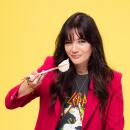A history of men’s hairstyles
- Share via
The ancient story of Samson and Delilah shows how important a man’s hairstyle can be. The tale has inspired sculptors, composers and screenwriters, and Samson’s long locks are part of a long list of classic men’s hairstyles. What follows is a look at other memorable men’s hairdos throughout history and in pop culture.
PHOTOS: Men’s hairstyles over time
2200 BC | Egyptian men wore their hair very short or they shaved their heads. Wealthy men or members of the royal elite would cover their heads with elaborate headdresses, wigs or hair extensions.
50 BC | The Roman emperor Julius Caesar wore his hair short and flat against his head, but brushed forward from the crown.
FOR THE RECORD:
Men’s hairstyles: A timeline in the Image section Jan. 29 about notable men’s hairstyles said that Albert Einstein won the Nobel Prize for the theory of relativity. Einstein won the Nobel in physics for his “services to theoretical physics” and for his discovery of the law of the photoelectric effect. —
AD 390-450 | Following the collapse of the Roman Empire, most of Europe adopted the hair and dress of the Germanic peoples. During the reign of the Merovingian dynasty, King Chlodio V was nicknamed “Le Chevelu” because he wore his hair longer than most of his predecessors. During this time, long locks were a symbol of status. Royalty wore their hair long while members of the lower classes and slaves either had short hair or shaved heads.
1600s | Having to wear a long wig might sound like social suicide to the modern man, but in 17th century France it was a sign of status, made popular by King Louis XIV. He made public appearances and frequently posed for portraits in a long, dark brown wig with loose waves.
1700s | President George Washington went against the trends of his day by not wearing a wig. Instead he powdered his own hair, and pulled it back, augmenting it with extra-long sideburns.
1800s | Author Charles Dickens was noted for his comb-over. He would comb a large chunk of hair from the right side of his head over to the left, creating a thick mess of curls.
1926-27 | The crew cut originated when Yale rowing team member Jock Whitney had his hair cut short and the rest of the team adopted the look. It may have been a way to tell them apart from members of the football team, who wore their hair longer for extra padding under their thin leather helmets. In 1895, the Yale football team also adopted the crew cut. During World War II, soldiers sported crew cuts to help control head lice in their tight quarters.
Early 1900s | Sure, Albert Einstein won the Nobel Prize in physics for his theory of relativity. But his long hair and seeming lack of interest in its appearance made his “mad scientist” persona legendary.
1920s | Actor Rudolph Valentino, pictured with Gloria Swanson, lighted up the silver screen with his defined side part and glossy jet black hair in such films as “Beyond the Rocks” (1922) and “The Young Rajah” (1922).
1950s | James Dean and Elvis Presley made the pompadour hairstyle famous for bad boys. The hair is cut short on the sides and left longer on top. It’s then combed forward and flipped up and back in one long wave, creating a voluminous pouf at the front of the hairline. Presley wore his style with thick sideburns.
1960s | The Beatles all sported the mop top early in their careers. Their brown locks were cut at uniform length with a fringe of long bangs just above the eyes.
Bob Dylan’s fine curly locks stood straight up on his head, which, for some, made the disheveled look something desirable.
Jimi Hendrix made the Afro hairstyle a must-try for anyone with naturally curly hair or a perm and a gift for teasing.
1970s | Dreadlocks have long had religious or mystical symbolism in Africa, India and other cultures. Reggae star Bob Marley of Jamaica brought them into the mainstream.
1980s | Michael Douglas made the slicked-back look famous when he portrayed Gordon Gekko in the film “Wall Street” (1987). The character’s hair proved to be a fitting style to go with the Gordon Gekko uniform: suspenders, collared shirts and printed ties.
The mohawk hairstyle was first associated with ancient mummies and the Native American Mohawk tribe, but it became a popular symbol of rebellion in the punk rock movement during the 1980s. It was achieved by shaving the sides of the head and spiking the middle hair with product. (In the ‘90s and 2000s, the style was still prominent among rockers such as Travis Barker from the band Blink-182.) The style gradually transitioned to the everyday wearable faux-hawk. This style features longer hair that has been gathered, raised and slightly spiked at the top of the head with product. Soccer players David Beckham and Cristiano Ronaldo have sported faux-hawks.
1990s | Kurt Cobain wore his hair parted down the middle, long and straight. This became “the” haircut for anyone starting a grunge band in their garage.
2000s | Donald Trump might be best known for his signature comb-over and its vulnerability to any gusts of wind. His thin red locks are meticulously swept across the top of his head, over his bald spot.
Justin Bieber drives teeny-boppers wild with his long, side-swept hair. The head whipping may have been necessary for him to see out from beneath his overgrown bangs, but it became a signature move for those rocking “The Bieber.”



